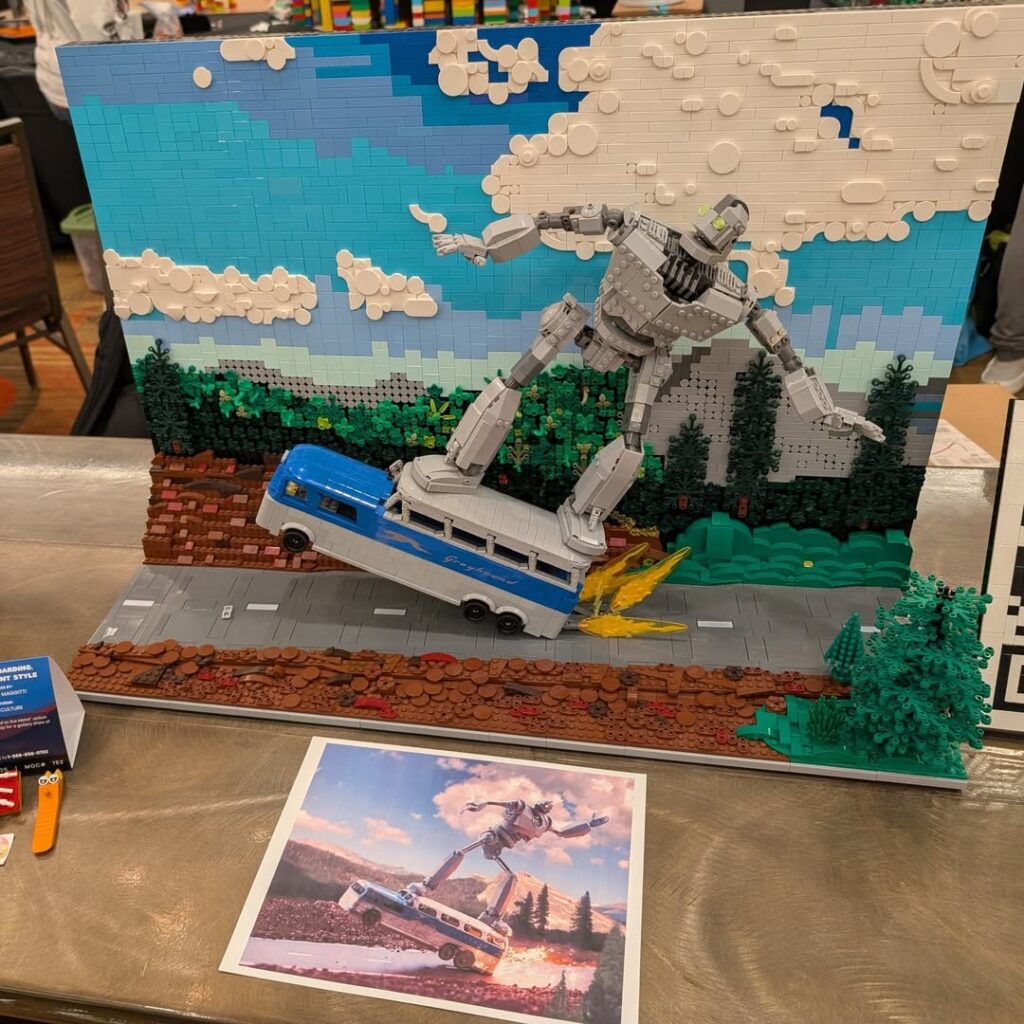The Iron Giant, Brad Bird’s 1999 animated masterpiece, is a film that occupies a special place in the hearts of animation enthusiasts and casual moviegoers alike. Its tale of friendship, identity, and sacrifice resonates across generations, fueled by its central character: a towering, gentle robot with a soul. But what happens when this beloved giant is reimagined brick by brick? Enter Jason Maggitti, a visionary LEGO artist who has transformed the Iron Giant from celluloid into an astonishing physical sculpture, using nothing but LEGO bricks.
This editorial explores Maggitti’s LEGO Iron Giant not merely as a sculpture but as a cultural statement — an intricate blend of nostalgia, technical prowess, and artistic vision. From the genesis of the idea to the engineering behind each joint and panel, we unravel how this project transcends typical LEGO builds to become a monumental homage to one of animation’s most endearing icons.
The Story Behind the Giant
Released at the end of the 20th century, The Iron Giant was underappreciated at its debut but grew into a beloved cult classic. The film tells the story of a massive robot who befriends a young boy named Hogarth Hughes and ultimately learns about humanity through their bond. The Giant’s mantra, “I am not a gun,” is a poignant commentary on identity and choice.
Jason Maggitti, a LEGO artist renowned for his skill in character builds and dynamic forms, saw an opportunity to immortalize this message through LEGO. Known for blending pop culture with LEGO’s geometric purity, Maggitti aimed to capture the Iron Giant’s emotional depth and mechanical detail without sacrificing either.
Concept to Blueprint: The Design Process
Unlike standard LEGO kits, which arrive with comprehensive instructions, custom sculptures like Maggitti’s Iron Giant begin with vision and evolve through trial, error, and painstaking planning. Maggitti began by studying the Iron Giant’s model sheets and film stills to capture proportions accurately.
He used LEGO Digital Designer and Bricklink Studio software to virtually plan the giant before physically assembling it. The digital phase allowed Maggitti to experiment with balance, articulation, and detailing without wasting bricks. This iterative process, similar to 3D modeling in digital art, forms the backbone of many contemporary LEGO masterpieces.
Maggitti’s design had to balance aesthetic fidelity with physical stability. The Iron Giant’s long limbs and slender joints are iconic but structurally challenging. Every angle, every hinge, and every stud had to be engineered to support the figure’s weight without compromising its elegant silhouette.
Engineering Challenges: Making a Robot Stand
Building a humanoid figure as large as the Iron Giant in LEGO presents unique structural challenges. Gravity, tension, and fragility are constant adversaries. Maggitti tackled these by integrating “Technic” elements — LEGO’s specialized line of beams, pins, and axles that allow for robust inner skeletons.
The inner frame of the Iron Giant functions much like an exoskeleton. Reinforced joints in the knees, hips, and shoulders ensure stability while allowing a surprising range of motion. This meant the Giant could be posed expressively — an essential quality for bringing a character known for gentle gestures to life.
The head, perhaps the most crucial component for emotional expression, posed another layer of complexity. Maggitti spent considerable time shaping the Giant’s eyes and jawline, ensuring they conveyed the correct warmth and curiosity rather than cold mechanical detachment.
Aesthetics: From Cold Metal to Warm Brick
One of the biggest artistic challenges in translating the Iron Giant into LEGO was replicating the character’s metallic essence using plastic bricks. Maggitti skillfully used a palette of grays, silvers, and carefully placed transparent pieces to mimic reflections and depth.
LEGO bricks, by nature, have a grid-based logic. Yet Maggitti’s sculpture feels organic, with smooth transitions and subtle curves that echo the Giant’s cinematic form. In areas like the chest and shoulders, where the Giant’s strength is symbolized, Maggitti used slope and wedge pieces to create muscle-like contours.
Additionally, small details such as rivets and panel lines were simulated using stud placements and layered tiles. These details reward close inspection, inviting viewers to step forward and experience the sculpture up close.
Symbolism and Emotional Resonance
Beyond its technical marvel, the LEGO Iron Giant embodies a profound emotional narrative. The original film’s central theme — the choice to be more than one’s programming — is subtly echoed in Maggitti’s medium choice. LEGO bricks, often associated with childlike play, become a medium for serious, contemplative art here.
In a way, the sculpture itself chooses to “be more.” Instead of being confined to sets or simple models, it transforms into a storytelling device. The Iron Giant’s eyes, slightly tilted head, and forward-leaning stance evoke innocence and curiosity — a direct callback to the character’s cinematic journey.
Furthermore, for adult LEGO fans (AFOLs), Maggitti’s work symbolizes a bridge between childhood imagination and adult craftsmanship. It reminds us that toys can be serious artistic media and that nostalgia can evolve into profound, modern creativity.
Culture
LEGO art has surged in popularity over the last two decades. From Nathan Sawaya’s globally toured “The Art of the Brick” to massive architectural models displayed in museums, LEGO has cemented its place in the art world.
Maggitti’s Iron Giant fits neatly into this evolving landscape. It’s not merely a fan homage but a contribution to the discourse on what constitutes art and who gets to define it. In an era of digital dominance, where 3D rendering and virtual reality often overshadow tactile arts, physical LEGO sculptures stand as a testament to human touch and patience.
Moreover, such builds connect communities. Online LEGO fan forums and conventions buzz with admiration and technical discussions whenever new large-scale sculptures are revealed. They serve as educational examples for aspiring builders and ignite interest in engineering, design, and art among younger audiences.
Technical Statistics and Brick Count
While Maggitti hasn’t publicly disclosed the exact brick count, similar large-scale builds typically range from 5,000 to over 10,000 pieces. Each piece has a role, from foundational Technic beams to tiny decorative tiles.
Standing several feet tall, the Iron Giant’s silhouette dominates a room, offering an almost architectural presence. Maggitti reportedly spent hundreds of hours across several months to complete the build — a testament to both dedication and technical mastery.
From Fan Art to Museum Piece
The line between fan art and gallery-worthy art blurs in works like this. Museums and galleries increasingly embrace LEGO as a legitimate medium, sometimes commissioning large installations or hosting competitions.
It’s not difficult to imagine Maggitti’s Iron Giant standing alongside modern sculptures in a contemporary art exhibit, where visitors might contemplate not just its pop-cultural roots but also its meticulous craftsmanship and emotional resonance.
Why the Iron Giant?
Choosing the Iron Giant as a subject is a decision rooted in emotional connectivity and narrative depth. Unlike other robots in pop culture, the Iron Giant symbolizes peace, choice, and humanity. It isn’t merely a machine; it’s a character who questions violence, seeks love, and ultimately sacrifices itself to protect others.
For Maggitti, selecting this character likely reflects a personal connection and an appreciation of its layered storytelling. It suggests that art can be a form of tribute — not just to a film, but to the ideals that film represents.
No comments yet.







